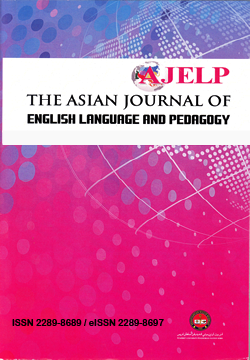A Bibliometric Analysis of Language Transfer Research: Trends and Hotspots
DOI:
https://doi.org/10.37134/ajelp.vol11.2.5.2023Keywords:
bibliometric analysis, hotspots, language transfer, second language acquisition, trendsAbstract
In recent years, the field of second language acquisition has witnessed a noticeable surge in the significance of language transfer research. This current study conducted a comprehensive bibliometric analysis of language transfer research within the time frame spanning 2012 to 2023, focusing on the primary research trends and hotspots. A dataset comprising 1259 documents, sourced from the Web of Science (WOS) was collected and subjected to meticulous analysis through the combined utilisation of the Statistical Analysis Toolkit for Informetrics 4.0 (SATI) software and VOSviewer. The findings shed light on the developmental trajectory, current status, and future trends in language transfer research, offering valuable insights for further research directions and pertinent recommendations. This study holds particular significance for practitioners in the field of language education, offering a comprehensive comprehension of the contemporary landscape of language transfer. Furthermore, its implications extend to the realm of research methodology, rendering valuable guidance for the application and utility of visualisation techniques within the sphere of language transfer exploration.
Downloads
References
Ariffin, K., Darus, N. A., Abdul Halim, N., & Awang, N. A. (2021). Analysing morphological errors in ESL graduating students’ writing based on surface structure taxonomy. International Journal of Modern Languages and Applied Linguistics (IJMAL), 5(3), 42-53.
Birkle, C., Pendlebury, D. A., Schnell, J., & Adams, J. (2020). Web of Science as a data source for research on scientific and scholarly activity. Quantitative Science Studies, 1(1), 363-376.
Chadegani, A. A., Salehi, H., Yunus, M. M., Farhadi, H., Fooladi, M., Farhadi, M., & Ebrahim, N. A. (2013). A comparison between two main academic literature collections: Web of Science and Scopus databases. arXiv preprint arXiv:1305.0377.
Chen, X., Geva, E., & Schwartz, M. (2012). Understanding literacy development of language minority students: an integrative approach. Reading and Writing, 25, 1797-1804.
Cummins, J. (1979). Linguistic interdependence and the educational development of bilingual children. Review of educational research, 49(2), 222-251.
Cutler, R. L., Fernandez-Llimos, F., Frommer, M., Benrimoj, C., & Garcia-Cardenas, V. (2018). Economic impact of medication non-adherence by disease groups: a systematic review. BMJ open, 8(1), e016982.
Elaish, M. M., Shuib, L., Ghani, N. A., Mujtaba, G., & Ebrahim, N. A. (2019). A bibliometric analysis of m-learning from topic inception to 2015. International Journal of Mobile Learning and Organisation, 13(1), 91-112.
Ellis, N. C. (2008). Usage-based and form-focused SLA: The implicit and explicit learning of constructions. Language in the context of use: Cognitive and discourse approaches to language, 93-120.
Garousi, V., & Mäntylä, M. V. (2016). Citations, research topics and active countries in software engineering: A bibliometrics study. Computer Science Review, 19, 56-77.
Harzing, A. W. (2019). Two new kids on the block: How do Crossref and Dimensions compare with Google Scholar, Microsoft Academic, Scopus and the Web of Science. Scientometrics, 120(1), 341-349.
Li, H.J., An, H., Wang, Y., Huang, J., & Gao, X. (2016). Evolutionary features of academic articles co-keyword network and keywords co-occurrence network: Based on two-mode affiliation network. Physica A: Statistical Mechanics and its Applications, 450, 657-669.
Lin, Z., & Lei, L. (2020). The research trends of multilingualism in applied linguistics and education (2000–2019): A bibliometric analysis. Sustainability, 12(15), 6058.
Liu, Q., & Ye, Y. (2012). A study on mining bibliographic records by designed software SATI: Case study on library and information science. Journal of Information Resources Management, 2(1), 50-58.
Liu, S., & Zhang, S. (2021). A bibliometric analysis of computer-assisted English learning from 2001 to 2020. International Journal of Emerging Technologies in Learning (iJET), 16(14), 53-67.
Liu, Z., Yin, Y., Liu, W., & Dunford, M. (2015). Visualizing the intellectual structure and evolution of innovation systems research: a bibliometric analysis. Scientometrics, 103, 135-158.
Martín-Martín, A., Orduna-Malea, E., Thelwall, M., & López-Cózar, E. D. (2018). Google Scholar, Web of Science, and Scopus: A systematic comparison of citations in 252 subject categories. Journal of Informetrics, 12(4), 1160-1177.
Odlin, T. (1989). Language transfer (Vol. 27). Cambridge: Cambridge University Press.
Perkins, K., & Zhang, L. J. (2022). The effect of first language transfer on second language acquisition and learning: From contrastive analysis to contemporary neuroimaging. RELC Journal, 00336882221081894.
Powell, T. H., Kouropalatis, Y., Morgan, R. E., & Karhu, P. (2016). Mapping knowledge and innovation research themes: Using bibliometrics for classification, evolution, proliferation and determinism. International journal of entrepreneurship and innovation management, 20(3-4), 174-199.
Roldan-Valadez, E., Salazar-Ruiz, S. Y., Ibarra-Contreras, R., & Rios, C. (2019). Current concepts on bibliometrics: a brief review about impact factor, Eigenfactor score, CiteScore, SCImago Journal Rank, Source-Normalised Impact per Paper, H-index, and alternative metrics. Irish Journal of Medical Science (1971-), 188, 939-951.
Selinker, L. (1969). Language transfer. General linguistics, 9(2), 67.
Vâlcea, C. S. (2020). First language transfer in second language acquisition as a cause for error-making in translations. Diacronia, (11), 1-10.
Van Eck, N., & Waltman, L. (2010). Software survey: VOSviewer, a computer program for bibliometric mapping. scientometrics, 84(2), 523-538.
Yu, D.J., & Liao, H. (2016). Visualization and quantitative research on intuitionistic fuzzy studies. Journal of Intelligent & Fuzzy Systems, 30(6), 3653-3663.
Zhang, X. (2020). A bibliometric analysis of second language acquisition between 1997 and 2018. Studies in Second Language Acquisition, 42(1), 199-222.
Downloads
Published
How to Cite
Issue
Section
License
Copyright (c) 2023 Meijuan Gai, Kamisah Ariffin, Badli Esham Ahmad, Yue Fang

This work is licensed under a Creative Commons Attribution-NonCommercial-ShareAlike 4.0 International License.





